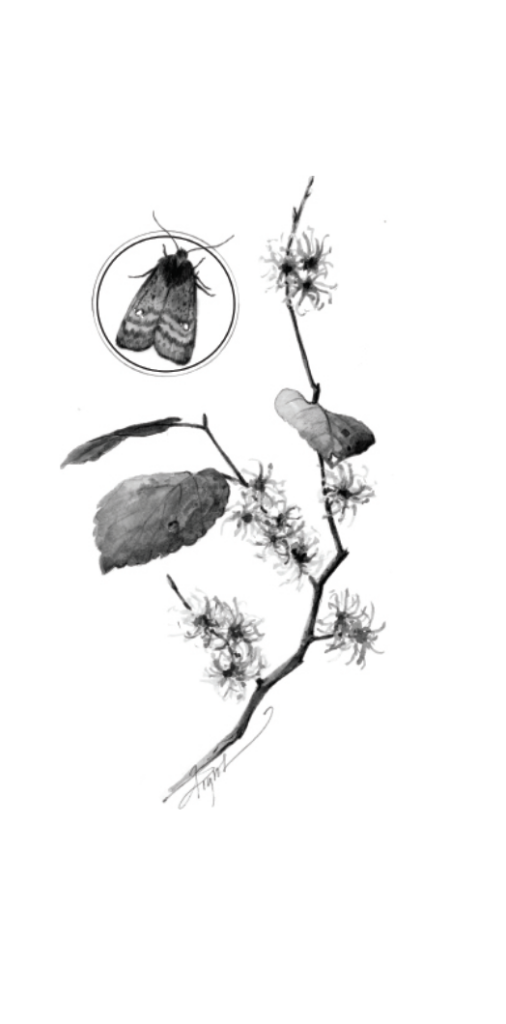In late autumn, well past the showy blossoms of summer, even after fall’s late bloomers have faded and the trees have dropped their leaves, there is one shrubby plant still putting on a flower show: American witch hazel (Hamamelis virginiana). Four slender, wrinkly yellow petals, about ¾ of an inch long, adorn each of the shrub’s flowers. These flowers, which grow along the ends of witch hazel’s branches, begin blooming in October and may persist into December. Like all flowering plants, witch hazel must be pollinated to produce fruit and seeds, and for this, it relies on insects. These include late-flying gnats and flies as well as forest-dwelling owlet moths, all drawn to the scented flowers and the sweet nectar within.
The large family of owlet moths, Noctuidae, includes some 12,000 species worldwide. Owlet moths are primarily nocturnal and therefore often go unnoticed. Some species are agricultural pests and are commonly known as armyworms or cutworms. The forest-oriented species that pollinate witch hazel flowers remain active after most other pollinators have died or retired for the season. Renowned biologist and naturalist Bernd Heinrich first documented the relationship between witch hazel and owlet moths belonging to the genus Eupsilia in a 1987 article published in Scientific American.
Cold-adapted owlet moths can stay active during nights when the temperature remains at or slightly below freezing. They do this by shivering, a behavior that can raise their body temperature by an impressive 86 degrees above the ambient air level. Heinrich observed owlet moths feeding on witch hazel flowers at the end of October. The key part of a moth’s body needing warmth, as Heinrich explained in his article, is the thorax. That’s where the wing muscles are, and heat is essential for them to keep functioning.
Pollinated witch hazel flowers produce fruit capsules, each containing two seeds. These capsules remain on the shrub for an entire year after pollination. Witch hazel’s genus name – Hamamelis, which translates to “fruit together”—is a nod to the coexistence of the flowers and seeds. Plants have evolved various mechanisms for seed dispersal, and witch hazel achieves it with something of a flare. In autumn, once a witch hazel seed capsule is fully developed, it ruptures, launching its pair of seeds into the air, sending them up to 30 feet from the parent shrub.
After launching and landing, the seeds settle into the duff where they will remain for up to two years. Like many seeds, those of witch hazel must go through “stratification”—a series of warm and cold conditions—before germinating. Witch hazel can also reproduce from vegetative sprouts. But cross-pollination and seed production are what allow for diversifying the gene pool, and witch hazel that sprouts from seeds is important for long-term adaptation and survival of the species.
In the Northeast, witch hazel grows in hardwood or mixed hardwood-and-conifer forest understories. Although it can reach small-tree height of 20 feet or more, it’s often smaller and usually multi-stemmed. Witch hazel is relatively easy to identify by its leaves, which have asymmetrical bases, distinctive veining, and wavy edges. In winter, the leaf buds look like deer hooves in profile. It might take a little imagination to see that detail, but it’s a feature that instructors in university dendrology courses often use for teaching tree and shrub identification.
Owlet moths are not the only organisms that benefit from witch hazel. Wild turkeys and other woodland animals eat the seeds, and deer browse the leaves and stems. And there’s another insect, one having no interest in the witch hazel flowers, that makes use of the shrub’s leaves. The witch hazel leaf gall aphid spends part of its life cycle in cone-shaped galls it creates on witch hazel leaves, which provide both food and shelter. The presence of these distinctive galls can even aid in identifying the shrub.
People have recognized witch hazel’s medicinal and therapeutic properties since at least pre-colonial times in North America, and it is still a common ingredient in many commercial products, including shampoos and lotions. More importantly, witch hazel provides a food source for late-flying owlet moths and other insects—and a bit of color to the late autumn woods.
D. Glenn Miller is a freelance writer and naturalist based in northeast Connecticut. His writing has appeared in American Forests magazine, Boys’ Life (now Scout Life), and the Hartford Courant. Illustration by Adelaide Murphy Tyrol. The Outside Story is assigned and edited by Northern Woodlands magazine and sponsored by the Wellborn Ecology Fund of the New Hampshire Charitable Foundation: nhcf.org.





